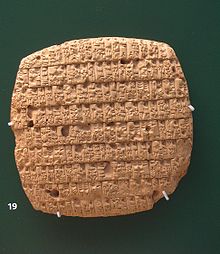Gaston Cros
Gaston Cros | |
|---|---|
First World War
| |
| Awards | Commander of the Mentioned in Despatches |
Colonel Marie Augstin Gaston Cros (known as Gaston Cros) (6 October 1861 – 10 May 1915) was a French army officer and archaeologist. He was born in
Upon the outbreak of the
Early life
Marie Augstin Gaston Cros was born at 2.00am on 6 October 1861 to Hippolyte Cros, a lawyer, and Marie Petronille Reine Scherb at
Cros transferred to the 4th Tonkinese Rifles on 3 June 1887 and saw active service in Tonkin (northern Vietnam) from 19 June 1887 to 14 September 1888, joining the 105th Infantry Regiment as a lieutenant on 5 October 1887.[3][4] He was awarded the Tonkin Expedition commemorative medal for his work in the country.[4]
On 25 January 1889 Cros transferred to the 4th
Archaeological work at Tello
From December 1901 Cros was placed in charge of the French-led Tello Expedition to the archaeological site of

Cros undertook numerous excavations at Tello producing significant numbers of artefacts, some dating from the earliest periods of Sumerian civilization.[5] One of his achievements, considered his most important at Tello, was the tracing of the great city wall which was 32.5 feet (9.9 m) thick.[11][12] In 1903 he discovered a doorway in the vicinity of de Sarzac's famous cuneiform tablets that provided evidence that the tablets were stored as part of a state administrative archive.[13]
During his time at Tello he remained nominally with the 39th Infantry Regiment, transferring to the
Cros transferred to the
Cros was later promoted to
First World War

After the outbreak of the
On 15 September Cros received temporary promotion to colonel and on 20 October was given command of the 2nd Moroccan Brigade at the Battle of the Yser.[1] His promotion was confirmed as permanent on 1 November 1914 and he became a commander of the Legion of Honour on 10 April 1915.[2][23] He also received a further mention in dispatches as "a brave soldier, an experienced great leader, wise, prudent, with natural authority" and was awarded the Croix de Guerre with palm.[2] In the spring he wrote to an archaeological colleague, Léon Heuzey, telling him that "I continue with my work as an archaeologist. As at Tello I record earthworks, but instead of artefacts of Gudea I find German shells, it is not without excitement".[20]

Later that year Cros led his brigade, as part of the
Cros' colleague Huezey described him later as "a trainer of men and a keen naturalist whose integrity was matched by his intelligence and bravery.
To the fallen of the Moroccan Division
Without fear, without mercy
To the memory of Colonel Pein, Commander of the 1st Brigade, of Colonel Cros, commander of the 2nd Brigade, officers, non-commissioned officers and soldiers of the Moroccan Division who gloriously gave their lives on 9, 10 and 11 May 1915. On 9 May 1915, the regiments of the Moroccan Division at 10AM launched their offensive from the Berthonval trenches and successfully overcame fierce resistance from the German side to claim victory over Hill 140, their objective - breaking through enemy lines for the very first time— Translation of the inscription on theMoroccan Division Memorial at Vimy.[27]
References
- ^ a b c d Boÿ, Général de brigade Jean. "Historique de la 66e promotion de l'Ecole spéciale militaire de Saint-Cyr (1881–1883), promotion d'Egypte" (PDF) (in French). Association des élèves et anciens élèves de l'école spéciale militaire de Saint-Cyr. Retrieved 29 December 2012.
- ^ a b c d e f g h i j k Charvát, Petr. "Dějiny archeologických výzkumů na Blízkém Východě" (in Czech). Západočeská univerzita v Plzni (Pilsen University, Czech republic). Retrieved 29 December 2012.[permanent dead link]
- ^ a b c d e f g h i j k "Legion of Honour records - page 14". Base Léonore. Ministère de la Culture. Retrieved 3 February 2013.
- ^ a b c d "Legion of Honour records - page 15". Base Léonore. Ministère de la Culture. Retrieved 3 February 2013.
- ^ ISBN 978-1-4068-2717-0.
- ^ "Legion of Honour records - page 21". Base Léonore. Ministère de la Culture. Retrieved 3 February 2013.
- ^ "Legion of Honour records - page 17". Base Léonore. Ministère de la Culture. Retrieved 3 February 2013.
- ^ S2CID 162753589.
- ISBN 978-1405189880.
- ISBN 90-5693-035-4.
- ISBN 9780766149120.
- ISBN 9781417977215.
- ISBN 9780931464966.
- ^ "Legion of Honour records - page 1". Base Léonore. Ministère de la Culture. Retrieved 3 February 2013.
- S2CID 163941416. Retrieved 29 December 2012.
- ISBN 978-1-4051-8988-0.
- ^ ISBN 978-0-312-12529-5.
- ^ Lyautey, Louis Hubert Gonzalve (1954). Lyautey l'africain: textes et lettres du maréchal Lyautey, Volume 2 (in French). Plon. pp. 187 & 196.
- ^ Recouly, Raymond (1920). Foch, the winner of the war. C. Scribner's Sons. p. 91.
- ^ a b c d Heuzey, Léon (2 July 1915). "Éloge funèbre de M. le commandant Gaston Cros, tué à l'ennemi". Comptes rendus des séances de l'Académie des Inscriptions et Belles-Lettres (in French). 59 (4): 244–5. Retrieved 29 December 2012.
- ISBN 9781419133695.
- ^ a b c Recouly, Raymond (1920). Foch, the winner of the war. C. Scribner's Sons. p. 104.
- ^ "Legion of Honour records - page 3". Base Léonore. Ministère de la Culture. Retrieved 3 February 2013.
- ^ ISBN 978-0-00-653174-6.
- ISBN 978-2-600-04098-3.
- ^ "Chromamix I" (PDF) (in French). Musée Zoologique de la Ville de Strasbourg. Retrieved 29 December 2012.
- ^ a b "Algeria, Egypt, Morocco and Tunisia 1914–1919" (PDF). Forgotten Heroes North Africans and the Great War 1914–1919. Forgotten heroes 14-19 foundation. Archived from the original (PDF) on 19 October 2014. Retrieved 29 December 2012.
